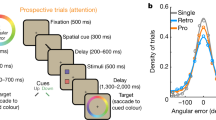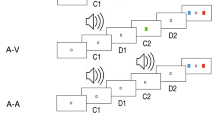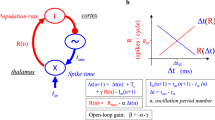Abstract
The prefrontal cortex is essential for the temporal integration of sensory information in behavioural and linguistic sequences1,2. Such information is commonly encoded in more than one sense modality, notably sight and sound. Connections from sensory cortices to the prefrontal cortex support its integrative function3,4,5. Here we present the first evidence that prefrontal cortex cells associate visual and auditory stimuli across time. We gave monkeys the task of remembering a tone of a certain pitch for 10 s and then choosing the colour associated with it. In this task, prefrontal cortex cells responded selectively to tones, and most of them also responded to colours according to the task rule. Thus, their reaction to a tone was correlated with their subsequent reaction to the associated colour. This correlation faltered in trials ending in behavioural error. We conclude that prefrontal cortex neurons are part of integrative networks that represent behaviourally meaningful cross-modal associations. The orderly and timely activation of neurons in such networks is crucial for the temporal transfer of information in the structuring of behaviour, reasoning and language.
This is a preview of subscription content, access via your institution
Access options
Subscribe to this journal
Receive 51 print issues and online access
$199.00 per year
only $3.90 per issue
Buy this article
- Purchase on Springer Link
- Instant access to full article PDF
Prices may be subject to local taxes which are calculated during checkout




Similar content being viewed by others
References
Luria, A. R. Higher Cortical Functions in Man (Basic Books, New York, 1966).
Fuster, J. M. The Prefrontal Cortex 3rd edn (Lippincott–Raven, Philadelphia, 1997).
Jones, E. G. & Powell, T. P. S. An anatomical study of converging sensory pathways within the cerebral cortex of the monkey. Brain 93, 793–820 ( 1970).
Pandya, D. N. & Yeterian, E. H. in Cerebral Cortex (eds Peters, A. & Jones, E. G.) 3–61 (Plenum, New York, 1985).
Romanski, L. M. et al. Dual streams of auditory afferents target multiple domains in the primate prefrontal cortex. Nature Neurosci. 2, 1131–1136 (1999).
Fuster, J. M. Unit activity in prefrontal cortex during delayed-response performance: Neuronal correlates of transient memory. J. Neurophysiol. 36 , 61–78 (1973).
Niki, H. Differential activity of prefrontal units during right and left delayed response trials. Brain Res. 70, 346–349 (1974).
Funahashi, S., Bruce, C. J. & Goldman-Rakic, P. S. Mnemonic coding of visual space in the monkey's dorsolateral prefrontal cortex. J. Neurophysiol. 61, 331–349 (1989).
Bodner, M., Kroger, J. & Fuster, J. M. Auditory memory cells in dorsolateral prefrontal cortex. NeuroReport 7, 1905– 1908 (1996).
Romo, R., Brody, C. D., Hernández, A. & Lemus, L. Neuronal correlates of parametric working memory in the prefrontal cortex. Nature 399, 470–473 (1999).
Fuster, J. M., Bauer, R. H. & Jervey, J. P. Cellular discharge in the dorsolateral prefrontal cortex of the monkey in cognitive tasks. Exp. Neurol. 77, 679–694 (1982).
Rao, S. C., Rainer, G. & Miller, E. K. Integration of what and where in primate prefrontal cortex. Science, 276, 821– 824 (1997).
Rainer, G., Asaad, W. F. & Miller, E. K. Selective representation of relevant information by neurons in the primate prefrontal cortex. Nature 393, 577–579 (1998).
Watanabe, M. Reward expectancy in primate prefrontal neurons. Nature 382, 629–632 (1996).
Petrides, M. & Pandya, D. N. in Handbook of Neuropsychology (eds Boller, F. & Grafman, J.) 17–58 (Elsevier, Amsterdam, 1994).
Wilson, F. A. W., Scalaidhe, S. P. O. & Goldman-Rakic, P. S. Dissociation of object and spatial processing domains in primate prefrontal cortex. Science 260, 1955–1958 (1993).
Desimone, R., Albright, T. D., Gross, C. G. & Bruce, C. Stimulus-selective properties of inferior temporal neurons in the macaque. J. Neurosci. 4, 2051–2062 (1984).
Miyashita, Y. Neuronal correlate of visual associative long-term memory in the primate temporal cortex. Nature 335, 817– 820 (1988).
Iwamura, Y., Tanaka, M., Sakamoto, M. & Hikosaka, O. Rostrocaudal gradients in the neuronal receptive field complexity in the finger region of the alert monkey's postcentral gyrus. Exp. Brain Res. 92, 360–368 (1993).
Tanaka, K. Neuronal mechanisms of object recognition. Science 262, 685–688 (1993).
Colombo, M. & Gross, C. G. Responses of inferior temporal cortex and hippocampus neurons during delayed matching to sample in monkeys (Macaca fascicularis). Behav. Neurosci. 108, 443–455 (1994).
Gibson, J. R. & Maunsell, J. H. R. Sensory modality specificity of neural activity related to memory in visual cortex. J. Neurophysiol. 78, 1263–1275 ( 1997).
Hikosaka, K., Iwai, E., Saito, H. & Tanaka, K. Polysensory properties of neurons in the anterior bank of the caudal superior temporal sulcus of the macaque monkey. J. Neurophysiol. 60, 1615–1637 (1988).
Zhou, Y. & Fuster, J. M. Neuronal activity of somatosensory cortex in a cross-modal (visuo-haptic) memory task. Exp. Brain Res. 116, 551–555 ( 1997).
Fuster, J. M., Bauer, R. H. & Jervey, J. P. Functional interactions between inferotemporal and prefrontal cortex in a cognitive task. Brain Res. 330 , 299–307 (1985).
Wise, S. P., Boussaoud, D., Johnson, P. B. & Caminiti, R. Premotor and parietal cortex: corticocortical connectivity and combinatorial computations. Annu. Rev. Neurosci. 20, 25 –42 (1997).
Tomita, H., Ohbayashi, M., Nakahara, K., Hasegawa, I. & Miyashita, M. Top-down signal from prefrontal cortex in executive control of memory retrieval. Nature 401, 699–703 (1999).
Matelli, M., Luppino, G. & Rizzolatti, G. Patterns of cytochrome oxidase activity in the frontal agranular cortex of macaque monkey. Behav. Brain Res. 18, 125–137 (1985).
Petrides, M. The effect of periarcuate lesions in the monkey on the performance of symmetrically and asymmetrically reinforced visual and auditory go, no-go tasks J. Neurosci. 6, 2054–2063 (1986).
Fuster, J. M. & Jervey, J. P. Neuronal firing in the inferotemporal cortex of the monkey in a visual memory task. J. Neurosci. 2, 361–375 (1982).
Acknowledgements
We thank W. Bergerson and B. Lubell for technical assistance; L. Fairbanks for statistical counsel; and C. R. Gallistel, J. Maunsell, W. T. Newsome, T. Sejnowski and Y. Zhou for valuable comments on the manuscript. This work was supported by grants from the National Institute of Mental Health.
Author information
Authors and Affiliations
Corresponding author
Rights and permissions
About this article
Cite this article
Fuster, J., Bodner, M. & Kroger, J. Cross-modal and cross-temporal association in neurons of frontal cortex . Nature 405, 347–351 (2000). https://doi.org/10.1038/35012613
Received:
Accepted:
Issue Date:
DOI: https://doi.org/10.1038/35012613
This article is cited by
-
Multiplexing working memory and time in the trajectories of neural networks
Nature Human Behaviour (2023)
-
Functional alterations of the prefrontal circuit underlying cognitive aging in mice
Nature Communications (2023)
-
Choice-dependent cross-modal interaction in the medial prefrontal cortex of rats
Molecular Brain (2021)
-
On the relationship between maps and domains in inferotemporal cortex
Nature Reviews Neuroscience (2021)
-
High-frequency Noise-induced Hearing Loss Disrupts Functional Connectivity in Non-auditory Areas with Cognitive Disturbances
Neuroscience Bulletin (2021)
Comments
By submitting a comment you agree to abide by our Terms and Community Guidelines. If you find something abusive or that does not comply with our terms or guidelines please flag it as inappropriate.



